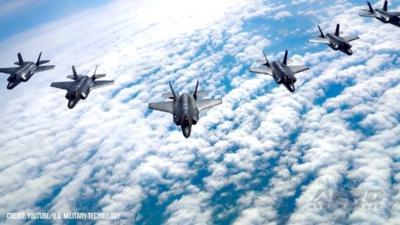Lightening the Lightning II Fleet
The U.S. Federal Government—after driving inflation to a forty-year high, allocating $1.2-trillion to a bloated infrastructure bill, and sending more than $54-billion to Ukraine—has found itself $1.4-billion short of the funds required to meet its contractual commitment to purchase F-35 Lightning II fighter jets from Lockheed-Martin.

Failure to find the monies will result in the fed’s pending three-year contract with Lockheed-Martin—valued at as much as $30-billion—yielding a disproportionately small number of F-35s—the controversial aircraft born of history’s priciest weapons program, now estimated to cost U.S. taxpayers an eye-watering $412-billion.
Runaway federal spending resultant of Congressional shortsightedness has seen the number of F-35s destined for U.S. military service drop from 485 in February 2019, to 404 in April 2019, to 375 aircraft in 2021. Now, in light of severely depleted federal coffers, production of F-35’s is likely to be cut even further.
A new list of so-called unfunded priorities sent to Congress by the DoD requests an additional $25-billion to cover shortfalls in the current military budget. The Pentagon blames inflation for the larger—$19.3-billion—portion of the deficit, and states an additional $1.4-billion is needed to cover increased military compensation costs. According to the document: “Currently, the [F-35] program has insufficient funds due to various cost drivers to fund the total planned quantities … Without these additional funds aircraft procurement will be reduced.”

The $1.4 billion deficit facing the F-35 program is the latest blight on a military-industrial juggernaut infamous for soaring costs and technical problems. According to DoD spokesman Russell Goemaere, causes of the prevailing shortfall include the higher per-aircraft cost due to COVID-19 and supply chain disruptions, global inflation, and a reduction in procurement quantities compared to the previous F-35 contract. Mr. Goemaere maintains that even in the absence of Congressional approval for additional funds, his office is authorized to award contracts by reducing the number of aircraft ordered.
Lockheed spokeswoman Laura Siebert argues the Pentagon’s request for additional F-35s ensures necessary quantities. “Quantities for each contract are determined by our customer,” Siebert put forth in a statement, “While we continue to see new international growth, U.S. services’ quantities have reduced.”
The Pentagon’s new unfunded priorities list expands on wants expressed earlier this year in concomitance with the DoD’s official defense budget request. The document was received Friday 11 November as Congress debated the amount by which to boost the military budget for the fiscal year that began 01 October.
Additional unfunded priorities put before Congress by the DoD include:
- The provision of $4.3-billion to compensate for record-high fuel prices. The Pentagon budgeted $119.70 per-barrel, but since 01 October, the per-barrel price of fuel has increased to $173.46.
- Increasing the basic allowance for military families by 12% over its current level rather than the 3.4% scheduled to go into effect in January 2023.
- Increasing the housing allowance for military families by 11% instead of the planned 4.2%.
- Allocating $1.26-billion to increase production of missiles and other munitions for purpose of replenishing inventories drawn down to arm Ukraine—including $240-million to step-up production of Lockheed’s Patriot missile system.
- Providing an additional $40-million to accelerate and increase production of 155-millimeter rounds such as the XM1128 and XM1113 projectiles manufactured by General Dynamics Corp.
- Increasing production of Boeing’s Harpoon missile system
Whether or not lawmakers heed the Pentagon’s entreaty remains to be seen. It is likely, however, that Congress will approve the Biden administration’s recent request to provide Ukraine an additional $37.7-billion.
 ANN FAQ: Contributing To Aero-TV
ANN FAQ: Contributing To Aero-TV Aero-News: Quote of the Day (12.10.25)
Aero-News: Quote of the Day (12.10.25) ANN's Daily Aero-Term (12.10.25): North Atlantic High Level Airspace (NAT HLA)
ANN's Daily Aero-Term (12.10.25): North Atlantic High Level Airspace (NAT HLA) Airborne 12.08.25: Samaritans Purse Hijack, FAA Med Relief, China Rocket Fail
Airborne 12.08.25: Samaritans Purse Hijack, FAA Med Relief, China Rocket Fail Airborne-Flight Training 12.04.25: Ldg Fee Danger, Av Mental Health, PC-7 MKX
Airborne-Flight Training 12.04.25: Ldg Fee Danger, Av Mental Health, PC-7 MKX




